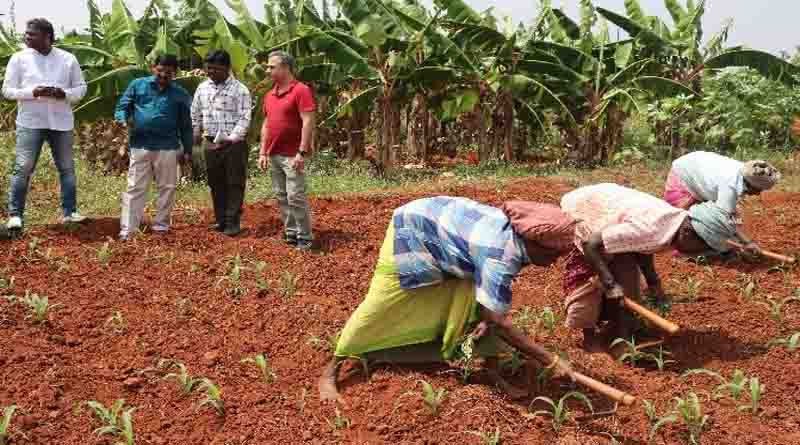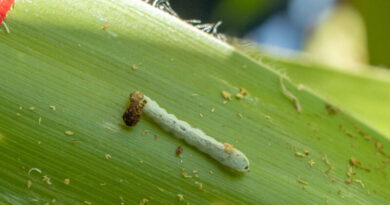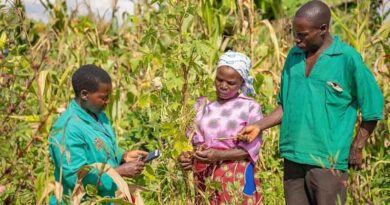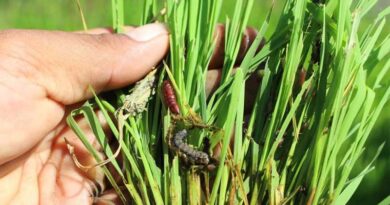Revolutionizing crop protection: Success of a novel approach to combatting fall armyworm in India
18 August 2023, India: The global battle against invasive pests has found a new champion with pioneering efforts to combat the fall armyworm (Spodoptera frugiperda) in India.
This is thanks to a sensor-based pheromone trap – that can be operated remotely anywhere in the world – and which has been created as part of a project funded by the UK Foreign, Commonwealth & Development Office’s (FCDO) Science and Innovation Network in India.
The work was led by CHAP together with consortium partners CABI, food chain data specialists Knowmatics and sensor experts Ystumtec. The project was also delivered in conjunction with the M S Swaminathan Research Foundation (MSSRF).
Highly invasive pest
The fall armyworm is a highly invasive pest, notorious for its capacity to inflict extensive damage to crops worldwide and has been the scourge of agricultural communities across continents.
After wreaking havoc on the cornfields of sub-Saharan Africa, the fall armyworm ominously arrived in India in 2018, heralding a new era of challenges for the agricultural landscape.
The scale of fall armyworm’s devastation cannot be underestimated. Its relentless assault quickly spread across the Indian subcontinent, infiltrating maize farms in 20 states.
This pest has posed a grave threat to smallholder farmers, especially due to the prevalence of maize monoculture and the escalating resistance resulting from overuse of pesticides.
The ripple effects of fall armyworm extend beyond corn crops, as it has demonstrated a voracious appetite for over 350 plant species, including rice, sugarcane, beet, potato, cotton, and grassland.
Crisis required a multifaceted approach
Addressing the fall armyworm crisis required a multifaceted approach. Recognizing the need for a coordinated sentinel network capable of collecting precise data on pest presence to predict risks for growers and communities, researchers embarked on a transformative journey.
This collaboration aimed to alert farmers to impending risks in a cost-effective manner, necessitating data that correlates commodity sensor signals and pheromone trap morphology with the presence of known pest species.
The absence of such critical datasets has impeded the establishment of a reliable sentinel network to generate timely alerts and guide farmers in adopting sustainable crop protection strategies.
In a ground-breaking leap toward solutions, the FCDO’s Science and Innovation Network in India provided essential funding for a phase one feasibility study in 2021. This monumental endeavour marked the inception of a novel sensor node, capable of transmitting vital data from fields at risk of FAW attack directly to farmers’ mobile devices.
Potential to optimise farming operations
Beyond merely bridging the information gap, this ingenious remote sensing device holds the potential to optimise farming operations, elevate yields, and offer valuable intelligence on pest presence.
As the project advanced, collaboration emerged as the cornerstone of success. The transformative phase sought to redesign hardware and quantify device efficacy through a partnership with Tamil Nadu-based entomology research.
This collaboration aimed to establish datasets that correlate sensor signals and pheromone trap morphology with known pest species’ presence, a crucial stride toward predictive analysis.
Yet innovation went beyond technology. Recognizing the diverse landscape of farmers, especially the approximate 30% of illiterate farmers in Tamil Nadu, the project employed generative user research methods.
Progressive web app
This approach delved into the motivations, pain points, and behaviours of farmer groups, leading to the creation of a user experience pathway that catered to all farmers, transcending literacy barriers.
The culmination of this effort was a progressive web app accessible to all farmers facing threats from invasive species like the fall armyworm.
The hardware aspect of the project was equally visionary. Focused on creating an accessible wind tunnel without compromising functionality, project partners embarked on a thorough literature search and design process.
The outcome was a wind tunnel predominantly constructed from locally available materials, ensuring ease of access and assembly. The incorporation of tools like 3D printers and laser cutters facilitated continuous improvements based on user feedback, reinforcing the project’s adaptive nature.
Revamped moth trap
Transitioning into the second phase, the project achieved significant strides. A revamped moth trap, designed by Ystumtec, underwent rigorous testing, yielding a version capable of reliably transmitting data over a range of 16 kilometres.
This advancement indicates that a single gateway installed at Pushkaram College of Agriculture Science could cover an impressive area of over 800 square kilometres.
Additionally, the user interface was enhanced to cater to diverse stakeholders, including farmers and agronomy advisors, fostering a robust information-sharing platform.
The project did not confine itself to technology development but delved into risk prediction as well. An essential component for farmers and advisors alike, the risk model aimed to forecast fall armyworm outbreaks.
By analysing crop, pest, and environmental factors, the model equips farmers with timely insights to alert supply chains, apprise local farmers of potential threats, and mitigate yield loss.
Dedicated research plot established
In tandem with these efforts, meticulous research and experimentation were conducted. A dedicated research plot was established in Tamil Nadu, observing the behaviour and lifecycle of the fall armyworm.
Facilities were set up for observing pupae and adult emergence, egg-laying processes, and flight behaviour. This foundation laid the groundwork for a multi-stakeholder ‘show and tell’ event, celebrating the culmination of phase two.
Testament to innovation, collaboration, and perseverance
In conclusion, the project stands as a testament to innovation, collaboration, and perseverance. From the establishment of new facilities and protocols to the development of user-centric apps, risk models, and culturing facilities, the team’s accomplishments are undeniably substantial.
The insights garnered from device installation and user training processes will guide future iterations and testing in the next phase. This endeavour signifies not only a resolute fight against fall armyworm but a model for addressing complex global agricultural challenges.
Also Read: Mahindra Tractors launches 7 new models under the OJA range for Indian farmers
(For Latest Agriculture News & Updates, follow Krishak Jagat on Google News)















